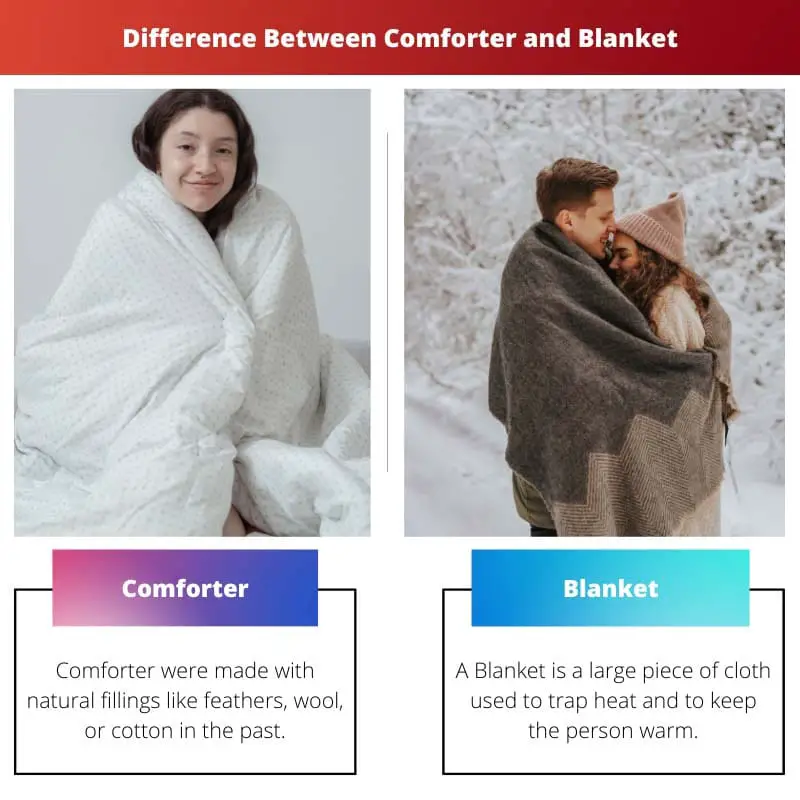People use clothing to keep themselves warm. In cold places like the Arctic, people use different materials like the wool of animals to survive the bitter cold.
People in areas with mild cold also use different kinds of bed sheets to make warm beddings and also use blankets to cover them. These blankets are made using different types of material to provide warmth.
Key Takeaways
- Comforters are thicker and more insulated than blankets, providing warmth during colder weather.
- Blankets are thinner and more versatile, making them suitable for various temperatures and uses.
- Comforters have a decorative outer layer and a filled inner layer, while blankets consist of a single layer of fabric.
Comforter vs Blanket
The difference between a comforter and a blanket is that a comforter comes with fillings in between two sheets On the other hand a Blanket is a single layer of Cloth. The fillings in a comforter may be cotton, wool, or any other synthetic material. Comforters provide more warmth than a Blanket.

A comforter is called by many names in different countries. In Australia, it is called a Doona while in the UK it has several names like a Continental Quilt or Duvet.
They were made with natural fillings like feathers, wool, or cotton in the past. Now they are made with synthetic filling made up of polyester.
A Blanket is a large piece of cloth used to trap heat and to keep the person warm. Blankets are large enough to cover the entire body of the person.
This traps the radiant heat from the body that is lost by convection. The fabric used to make a blanket is soft.
Comparison Table
| Parameters of Comparison | Comforter | Blanket |
|---|---|---|
| Layers | Three or more | Single |
| Price range | Costly | Affordable |
| Heat range | Provides more heat | Medium amount of heat |
| Suitable Season | Winter | Summer and Winter |
| Maintenance | Hard | Easy |
What is a Comforter?
Comforters were initially made in China around 3000 B.C. They were also used by the Norse Vikings to survive the extreme cold of Norway. In the 17th century, people all over Europe started using comforters.
Feathers of ducks and geese were used to make pillowcases at that time. But as time passed new materials were used as substitutes for the natural fillings used.
Comforters are spread above the top bed sheet. The present-day synthetic comforters are the modern form of duvets made using feathers. Comforter covers are also made using different materials to protect the inner fabric.
These covers are made just like pillowcases with zipper or button closure. Using comforter covers also helps to use the comforter for a long time.
Comforters are sold along with the bed. They come in bags with handles along with other bedding materials like pillow covers and bedsheets. All these bedding essentials are of a similar pattern.
Comforters are very helpful during winter. They cannot be used during summers because they are very thick normally. But, the thickness of comforters varies.
The insulation provided also depends on the type of filling used and the thickness. Comforters also come in different bed sizes. Queen, king, twin, and full-size comforters can be purchased.
The outer covers are made up of polyester, cotton, silk, or any other synthetic material. The color and design of comforters differ and people can buy one of their choices.

What is a Blanket?
Blankets make people feel cozy. They are mainly used during winters and also in other seasons. The term blanket was used to call a heavy woven fabric in the 14th century.
It was derived from the last name of a pioneer in weaving, Thomas Blanquette. Shakespeare used this word in his work King Lear. It was called Kambala in India.
A Chinese traveler reported the usage of Kambala or Blanket in India during 629-645 CE. This was described as a Woolen material made out of the hair of goats or sheep.
Evidence for the usage of Blanket in ancient India is available in Atharvaveda and Mahabharata. In Mahabharata, Gandhara is famous for its blankets.
Blankets were used by Indian herdsmen to get warmth while going out in cold weather and also to spread them on animals like horses or elephants. Various types of blankets are available now.
The texture and quality of blankets in each country differ. Design and pattern also differ among different cultures. Wool is the common fabric used. Cotton is used for thin blankets that can be used in summers.
Blankets can be of any type like woven, knitted, or crochet blankets. Baby blankets are special types of blankets used to cover infants and keep them warm. These baby blankets are made with soft material.
A picnic blanket can be spread on the ground and used to prevent soiling the clothes. Military soldiers use woolen blankets to survive cold. The blankets they use are subtle in color.

Main Differences Between Comforter and Blanket
- A comforter has two layers of outer covering and a middle layer of fillings. While the blanket is of single layer
- Comforter keeps you warm more than a blanket does. This is because a comforter has several layers and it is a better insulator. Blanket on the other hand does not retain more heat
- Comforters can make people sweat during summers and they are not suitable for hot weather but certain types of blankets can also be used for summer
- Comforters have more loft and are quite hard to store, but blankets can be folded easily and they only occupy a smaller space hence easy to store
- Comforters are more expensive than Blankets. This is due to the steps and processes involved in manufacturing a comforter but, blankets are affordable

- https://journals.sagepub.com/doi/abs/10.1177/0009922813482517
- https://www.researchgate.net/profile/Allison-Burkette/publication/286385932_Blanket_Coverage_Pointers_for_Conducting_Lexical_Research_with_Atlas_Data/links/56685c5008ae193b5fa06826/Blanket-Coverage-Pointers-for-Conducting-Lexical-Research-with-Atlas-Data.pdf
